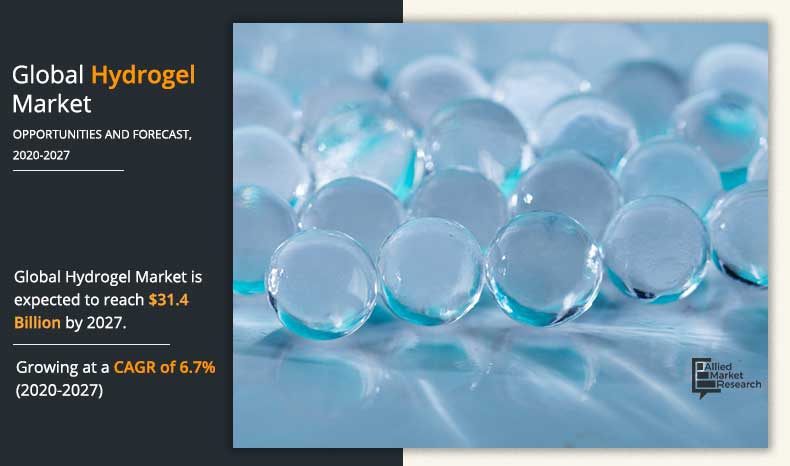Allied Market Research published a report, titled, "Hydrogel Market by Raw Material Type (Synthetic, Natural and Hybrid), Composition (Polyacrylate, Polyacrylamide, Silicone-modified hydrogels, Agar and Others), Form (Amorphous and Semicrystalline), Product (Semicrystalline buttons, Amorphous Gels, Impregnated Gauze, Films and Matrices and Hydrogel Sheets), and Application (Contact Lenses, Hygiene Products, Wound Care, Drug Delivery, Tissue Engineering and Others): Global Opportunity Analysis and Industry Forecast, 2024-2033". According to the report, the hydrogel market was valued at $23.4 billion in 2023, and is estimated to reach $45.7 billion by 2033, growing at a CAGR of 6.9% from 2024 to 2033.
A hydrogel is a three-dimensional (3D) network of hydrophilic polymers that can swell in water and contain a high amount of water while maintaining their structure due to chemical or physical cross-linking of individual polymer chains. A hydrogel is a material that contains at least 10% water by weight/volume.
Because of their high water content, hydrogels are extremely flexible, similar to natural tissue. The network's hydrophilicity is due to the presence of hydrophilic groups such as -NH2, -COOH, -OH, -CONH2, -CONH -, and -SO3H.
Hydrogels are some of the most fascinating soft materials that have been widely researched and exploited in the biomedical area due to their unique qualities such as high water content, softness, biocompatibility, low cost, and general ability to mimic soft human tissues. Hydrogel research is rapidly expanding, opening up new avenues for advanced biomedical research in areas such as drug release systems, tissue engineering/regeneration, wound healing, sensor technologies, and pharmaceutical applications.
Download Sample Pages of Research Overview: www.alliedmarketresearch.com/request-sample/1399
Market Drivers and Trends:
The market growth is driven by the success of super absorbent polymers in hygiene and wound care products, increased use of contact lenses, and the availability of various chemistries and formulations. Hydrogel usage in wound care is expected to rise rapidly due to its ease of use, water retention efficiency, and time efficiency during medical procedures and wound closure.
Additionally, growing awareness about available hydrogel formulations has spurred R&D investments to develop new hydrogel products, further propelling market growth. However, high production costs and potential environmental hazards associated with disposable synthetic hydrogel products may restrain market expansion.
Segmentation and Key Findings:
In 2015, contact lenses and hygiene products jointly accounted for three-fourths of the world hydrogel market.
The contact lenses segment is expected to grow at a CAGR of 5.8% from 2016 to 2022.
The wound care segment is projected to be the fastest-growing end-user segment, registering a CAGR of 7.9% from 2016 to 2022.
Synthetic raw material-based hydrogels are expected to lead the market throughout the forecast period.
North America, led by the U.S., dominated the hydrogel market in 2015 and is forecasted to grow at a CAGR of 6.3% during the forecast period.
Asia-Pacific is expected to grow at the highest CAGR of about 7% from 2016 to 2022, driven by increased adoption of hydrogel products in hygiene, contact lenses, and wound care products.
Procure Complete Report (300 Pages PDF with Insights, Charts, Tables, and Figures) @ https://www.alliedmarketresearch.com/checkout-final/9e9bc787c7b5ffd2f6ec95baea65ceb0
Semicrystalline segment to maintain its dominance by 2033
Based on form, the semicrystalline segment held the highest market share in 2023 and is estimated to dominate during the forecast period. Increase in demand for the semicrystalline form in the hydrogel market is driven by its superior mechanical properties, thermal stability, and controlled swelling behavior.
These attributes make semicrystalline hydrogels ideal for applications requiring durability and precision, such as in medical devices, drug delivery systems, and tissue engineering. In addition, their enhanced structural integrity and responsiveness to environmental stimuli cater to advanced technological and biomedical applications, further boosting their popularity in the market.




